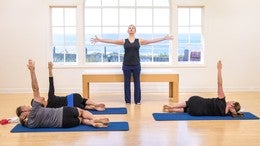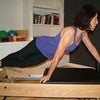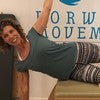Description
About This Video
Transcript
Read Full Transcript
Hi Shelly power here from Pollstar Palazzos. And so happy to be here at is anytime talking about the neck and I get a lot of questions asked of me, why does my neck hurt when I do plots or how can I get rid of the strain that I feel when I'm doing mat work? Um, I'd like to do more but it's kind of bothersome. So I have Aaron here today. She's in to help, um, explain how we can better do our mat classes with less strain. And actually the good news is it really doesn't have that much to do with your neck. Um, and also just give you a little bit of an idea of how the head sits on top of the neck and where we're really supposed to move from. And the head is heavy. It weighs about 10 pounds.
So if you're trying to hold it up in the middle of a mat class, yeah, I'm bet that doesn't feel very good. So I'm going to have Aaron turnaround so we can look at just where your head goes. So you can see that the head is on top of the neck and most people think that it really connects back here, back at the back of the skull. That's what often it feels like. But really your head attaches to your neck in this space, just behind your jaw here and right about there.
So you can put your fingers there and it's a little place where there's a nod of the head. It's like the vertebra sit up and they cradle the skull. And so we have this nodding feeling right back and forth so the head can say yes that way. And then there's another connection 0.1 segment lower that allows us to turn the head no. And that's up really high. And so sometimes when you hear the Q chin to chest, that's actually not the best cue because it actually compresses your neck. So we don't want to do that.
So we have that nodding feeling and you can try this at home. So if you sit up really tall just or even stand where you are right now, and imagine that there's a paintbrush coming out of your head reaching all the way to the ceiling. This is something that you've gentry used to teach a called paint the ceiling and you can start to nod your head back and forth. You can go side to side and if you practice, you can even go in circles of this feeling of moving the head right on top of the neck. Great. So now let's look at this from actually what we're going to do in a math class.
So go ahead and lie down Aaron, if you would. And the other question I get is do I put something behind my head? Should I put something behind my neck? How do I know? What do I do? So I have a couple of things here. We have towels, we have cushions. And if Aaron was in my class as a teacher, I probably wouldn't change her position because her head is nicely aligned with her body.
But tip your head back a little bit and let your Chin come up to the ceiling and then put your head down. You can see how now her head's not in that great of a position. Her Chin is up and there be some strain there. Plush, it feels like she's falling over backwards. So if that was the case, I would lift your head. I would put something just behind the head here that would prop it up just a little bit. And what we're trying to do, our goal is to bring the head in alignment with the body. So we wouldn't want to have it like this. That's too far forward, but we also wouldn't want to have it like that.
So you can choose what kind of pad or tile you use that puts it in the best position. Now let's talk about rolling up. So here's the lying down is great. That feels wonderful. But now we actually have to roll up and do something often like the hundred, which you have to hold your head up for a long time. So go ahead and take your hands and place them over your chest or a couple of different ways that we can think about rolling. So if you do that little tiny nod, that's what we just practiced and then continue to curl up and then roll back down. That starts the head without taking the chin to the chest.
And now we can use the body to roll up as opposed to using all the little tiny neck muscles. Okay. Another way you can practice is to interlace your hands behind your head and really interlace your hands. It's funny, some people want to do this, but I want you to put your hands there so your head presses back just a little bit. And then we have the same idea of a little bit of a nod to roll up and roll back down. Another thing you can think of too is where your eyes are looking. So if you roll up and your eyes look behind you, that's not very, everything's not going in the same direction. So make sure you're looking somewhere out in the distance, over your knees, or over your thighs. Um, that feels comfortable to you.
So thank you so much for joining me. I hope that you find this helpful, that this, um, makes it possible for you to do some of the plottings mat work and feel great in your neck.
Comments
You need to be a subscriber to post a comment.
Please Log In or Create an Account to start your free trial.












